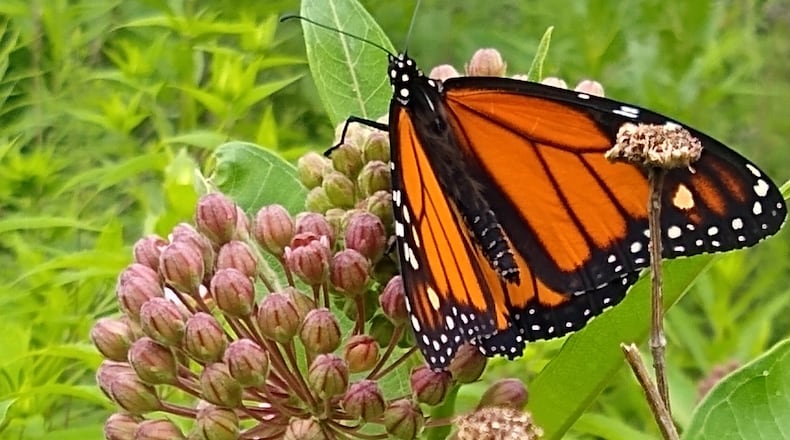Ron Corbett of Native Ohio Plants, LLC in Tipp City, a small backyard plant nursery, says that people should grow native plants because the non-native or exotic plants sold by most nurseries often “do not provide essential food or habitat resources for the wildlife”—even if they were introduced to an area hundreds of years ago. In contrast, native plants are “year-round bird feeders” and the base of the food chain in a functional ecosystem, says Austin Miller of Birdsong Landscapes in Springboro.
Ruth Bowell of The Milkweed Patch, LLC in Troy explains that some animals, such as the monarch, can eat only specific native plant species. Monarch larvae eat only milkweed, so the plants are critical to the survival of the beleaguered butterfly. Molly Kenney of Down Nature’s Path, LLC in Greenville adds that many native bees and other insects also require particular native plants. Both businesses focus on native plants beneficial to pollinators, such as native asters and blazing stars. The Milkweed Patch also carries several milkweed species native to Ohio.
Charlie Greene of Tadmor Greenes (started in 2022) and Kara Maynard of Deeply Rooted Landscapes note that native plants are easier to grow because they don’t require chemical fertilizers or pesticides and need little nurturing once they are established. “Native plants are the best garden you can grow,” says Maynard, because they are adapted to local soil types and weather patterns and thrive with little effort on the homeowner’s part if planted in the right location (paying attention to the preferred moisture level, sun exposure and soil types).
“If you don’t have time to garden,” Greene adds, “then get native plants!”
The nursery owners also point out that autumn is an ideal time to add native plants. Corbett explains that fall means plants are preparing for winter dormancy, and cooler temperatures reduce stress on the plants. Trees and shrubs do especially well with fall planting, he says, needing perhaps only one or two strategic waterings before settling in for the winter. Fall planting also helps establish plants for growth in the spring and makes them “better able to withstand the heat of next summer.”
Bowell notes that increased precipitation in fall and winter helps plants become established before winter. Greene adds that a fall planting means there will be less need for watering the following summer. “You only have to water native plants to get them established,” he says. “Then you leave them alone and watch the bees and birds enjoy them.”
Kenney observes that gardeners can make use of autumn’s fallen leaves to help prepare planting beds. “Put them on top of your beds and let them break down over the winter and spring,” she says. Corbett says that many native plants can thrive with little site preparation, but the addition of fall leaves is especially beneficial for shade-loving plants, which evolved to grow in the decomposing leaves on forest floors.
While all of the businesses are happy to provide gardeners with resources on how to prepare a site, plant, and care for native plants themselves, some also offer these services. Corbett, Maynard and Miller provide garden design services, site preparation (including removal of invasive species), delivery and planting to help homeowners restore native ecosystems. Birdsong Landscapes specializes in seeding native prairies and converting large lawns into native landscapes.
Some also offer educational experiences. Deeply Rooted Landscapes recently began a native plant workshop series, while The Milkweed Patch gives presentations on monarch- and pollinator-related topics to interested groups. In addition, Tadmor Greenes soon plans to teach about seed collecting and best gardening practices (to help native pollinators and birds survive the winter) at the native gardens around The Foodbank, which receives a portion of profits from Tadmor Greenes plant sales.
Proof of the benefits of native plants can be seen in some local gardens. Sue Howorth and Maura Boesch of Kettering have both transformed their properties with numerous native plant species. Howorth began “seriously” growing native plants in 2014 after volunteering with the Marianist Environmental Education Center of Dayton, which hosts an annual native plant sale. She says her backyard pollinator garden is “alive with all types of insects and birds” and “the number of types of butterflies I see keeps increasing.” Boesch started growing native plants over 20 years ago and says that they “are colorful and easy to grow, but beyond the visible display lives another world.” She adds, “It’s an honor to witness this world every season.” Both of their properties were featured in the Midwest Native Plant Society’s annual Homegrown Habitats Yard Tour in August.
Gardeners can purchase native plants from Birdsong Landscapes, Deeply Rooted Landscapes, Down Nature’s Path, The Milkweed Patch, Native Ohio Plants and Tadmor Greenes at 2nd Street Market, 600 E. Second Street, on Saturday, Oct. 2, from 11 a.m. to 3 p.m. The nurseries also sell at festivals, special events and multi-vendor locations in spring, summer and fall, and Deeply Rooted Landscapes has an online store. Check their websites for details.
Kari Carter is a member of The Journalism Lab of Dayton and an instructor at Sinclair Community College.
About the Author




